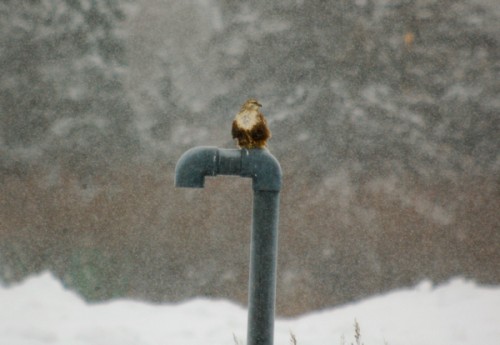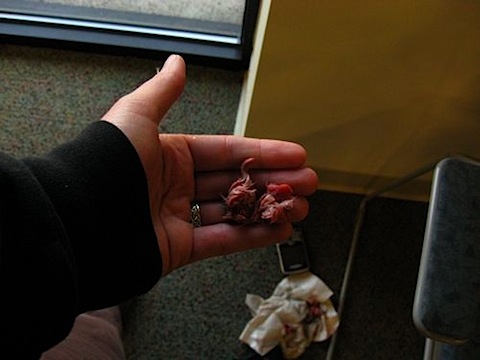UPDATE: I'VE ADDED SOME MORE INFORMATION ABOUT THIS STORY FROM THE ASSOCIATED PRESS. THE NEWS IS IN BOLD, MY COMMENTS ARE IN REGULAR TYPE
Two birds have died, but most of the remaining may soon be released.
Another 20 eagles died Friday after dozens swarmed an uncovered truck full of fish waste outside a processing plant in Kodiak, Alaska.
The birds became too soiled to fly or clean themselves, and with temperatures in the midteens, began to succumb to the cold. Some birds became so weak they sank into the fish slime and were crushed.
The truck's contents had to be dumped onto the floor of the Ocean Beauty Seafoods plant so the birds could be retrieved.
Workers from the seafood plant and the U.S. Fish and Wildlife Service washed the birds in dishwashing soap to help remove the fish oil. The birds spent the night drying out in a warehouse space, Gary Wheeler of the Kenai National Wildlife Refuge told the Anchorage Daily News.
U.S. Fish and Wildlife officers are investigating the incident.
Eagles are protected under federal law and killing them is a crime.
It is still to early to determine what penalties, if any, the seafood company may face, said Kim Speckman, a special agent who is part of the investigation.
Officers consider numerous factors looking into incidents such as this, including intent, she said.
"It's pretty obvious in this case nobody intended to break the law," Speckman said. The seafood plant has been very responsive and cooperative, she said.
HERE IS MORE FROM THE ALASKA DAILY NEWS:
Era Aviation and Alaska Airlines are bringing the birds from Kodiak to Anchorage so they can be cleaned and cared for by the Bird Treatment and Learning Center before being returned to the wild.
Six of the eagles arrived on afternoon flights Sunday and 12 more were expected on evening flights, said Cindy Palmatier, director of avian care at the center.
The rest of the birds should arrive on flights today, said Gary Wheeler, manager of the Kodiak National Wildlife Refuge, which has been caring for the birds since Friday's bizarre episode at the Ocean Beauty Seafoods plant in Kodiak.
Twenty bald eagles died when about 50 of the birds dived into an uncovered dump truck filled with fish guts.
Most of the dead birds were drowned or crushed in the gooey substance, which one wildlife official in Kodiak likened to quicksand. Two died later Friday night, but the rest appear to be getting better, Wheeler said.
"They're getting a little feisty now," he said. "They're feeling their oats, for sure, so you can tell they're feeling better. They're more perky. They're wanting to fly."
Wheeler said wildlife workers in Kodiak planned to wash the eagles again this weekend when a bird biologist with the International Bird Rescue and Research Center recommended sending the birds to the rescue center in Anchorage instead.
"The folks there have more expertise," Wheeler said. "This is the first time since the Exxon Valdez oil spill that we've had to handle this many birds. We've kind of improvised."
No one's certain where the eagles will be released once they have recovered.
The city of Kodiak -- home to about 500 eagles, Wheeler said -- would like them back. But the logistics of flying the eagles back to Kodiak -- three on this flight, five on that flight, until all 30 have made the trip -- could mean they're released in Anchorage, Palmatier said.
At least there's no rush to determine the birds' fates. The eagles are likely to remain at the recovery center for at least two weeks, Palmatier said.
If bird lovers want to help, she added, they can do so in two ways -- by donating salmon (frozen is fine; processed is not) or cash.
The salmon will help keep the eagles fed and the money will help pay for the center's utility bills, which are expected to soar as high as an eagle with so many birds to take care of.
Workers at the center cranked up the heat this weekend to between 75 and 80 degrees to keep the eagles warm, and it will use a lot of hot water in the coming days to wash and rinse the birds.
Keeping the birds warm is as important as getting them clean, Palmatier said, because the birds can't stay warm by themselves with feathers soiled by oily fish guts.
"They don't have a lot of thermal regulation because of the oil," she said. "They're very cold."
And stinky.
"It's a new form of aromatherapy," Palmatier said with a laugh as she described the scene at the center. "It smells very fishy."
What I want to know is, what made the eagles fly into the tank? Most birds have a poorly developed sense of smell, but were the eagles able to smell the fish oil? When the first bird got in and stuck, did that activity to get out attract more eagles? Are they able to see the fish oil in the ultra violet spectrum and that's what attracted them to the chum? Has anything like this happened before? I wonder if this has happened with birds people don't care about like double crested cormorants but because it was a few dozen bald eagles this time it gets media attention? I'm curious to see where this goes.
I also think that's it's speaks volumes about the company that it helped get the eagles out by dumping the nasty contents onto the factory floor and the workers helped clean the eagles.
Also, that's a whole lotta birds for a rehab center to get in all at once. If anyone has a spare few bucks, you might consider sending a little to the Bird Treatment and Learning Center. Given the daily readership here, if only a third of us gave $5 bucks, that would be a good size donation towards fish purchases.

 Rough-legged hawk in the snow. This is a bird being seen in the New Brighton area of the Twin Cities. I found it hunting an open area along with 2 red-tailed hawks--buteos getting along. Apparently it's been around awhile. I see it's sunny today, I may go back out and get some sunny photos.
Rough-legged hawk in the snow. This is a bird being seen in the New Brighton area of the Twin Cities. I found it hunting an open area along with 2 red-tailed hawks--buteos getting along. Apparently it's been around awhile. I see it's sunny today, I may go back out and get some sunny photos.

